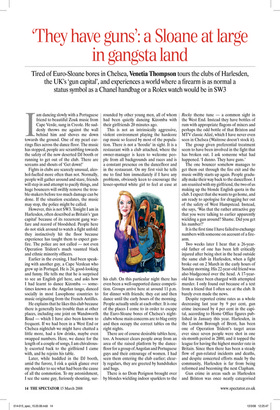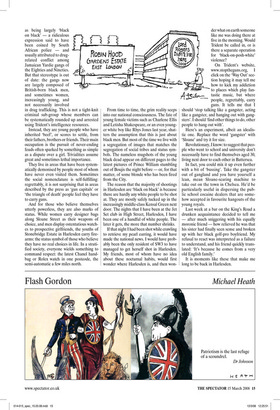‘They have guns’: a Sloane at large in gangsta land
Tired of Euro-Sloane bores in Chelsea, Venetia Thompson tours the clubs of Harlesden, the UK’s ‘gun capital’, and experiences a world where a firearm is as normal a status symbol as a Chanel handbag or a Rolex watch would be in SW3 Iam dancing slowly with a Portuguese friend to beautiful Zouk music from Cape Verde, sung in Creole. He suddenly throws me against the wall behind him and shoves me down towards the ground. One of my pearl earrings flies across the dance floor. The music has stopped, people are scrambling towards the safety of the now deserted DJ booth or running to get out of the club. There are screams and shouts of ‘Get down!’ Fights in clubs are scarcely unusual, alcohol-fuelled more often than not. Normally, people will gather around and stare, friends will step in and attempt to pacify things, and huge bouncers will swiftly remove the trouble-makers before too much damage can be done. If the situation escalates, the music may stop, the police might be called.
However, this is not SW3. Tonight I am in Harlesden, often described as Britain’s ‘gun capital’ because of its recurrent gang warfare and record of bloodshed. People here do not stick around to watch a fight unfold: they instinctively hit the floor because experience has taught them to expect gunfire. The police are not called — not even Operation Trident’s much vaunted black and ethnic minority officers.
Earlier in the evening, I had been speaking with another guy, a Cape Verdean who grew up in Portugal. He is 24, good-looking and funny. He tells me that he is surprised to see an English girl here, and asks how I had learnt to dance Kizomba — sometimes known as the Angolan tango, danced socially in most Lusophone countries to music originating from the French Antilles.
He explains that he likes this club because there is generally less trouble than at other places, including one joint on Wandsworth Road — which I have also been known to frequent. If we had been in a West End or Chelsea nightclub we might have chatted a little more, had a few drinks, maybe even swapped numbers. Here, we dance for the length of a couple of songs, I am chivalrously escorted back to the girlfriend I came with, and he rejoins his table.
Later, while huddled in the DJ booth, amid the furore, I risk a quick glance over my shoulder to see what had been the cause of all the commotion. To my astonishment, I see the same guy, furiously shouting, sur rounded by other young men, all of whom had been quietly dancing Kizomba with their girlfriends 20 minutes ago.
This is not an intrinsically aggressive, violent environment playing the hardcore rap music so feared by most of the population. There is not a ‘hoodie’ in sight. It is a restaurant with a club attached, where the owner-manager is keen to welcome people from all backgrounds and races and is a constant presence on the dancefloor and in the restaurant. On my first visit he tells me to find him immediately if I have any problems, obviously keen to encourage the lesser-spotted white girl to feel at ease at his club. On this particular night there has even been a well-supported dance competition. Groups arrive here at around 11 p.m. for dinner with friends; they eat and then dance until the early hours of the morning. People actually smile at each other. It is one of the places I come to in order to escape the Euro-Sloane bores of Chelsea’s nightclubs whose main concerns are to blag entry and then occupy the correct tables on the right nights.
There are of course desirable tables here, too. A bouncer clears people away from an area of the raised platform by the dancefloor for a group of Angolan and Portuguese guys and their entourage of women. I had seen them entering the club earlier; clearly regulars, they are greeted by handshakes and hugs.
There is no Dom Perignon brought over by blondes wielding indoor sparklers to the Rocky theme tune — a common sight in the West End. Instead they have bottles of rum with appropriate flagons of mixers and perhaps the odd bottle of that Brixton and MTV classic Alizé, which I have never even seen in Chelsea (Waitrose doesn’t stock it).
The group given preferential treatment seem to have been involved in the fight that has broken out. I ask someone what had happened. ‘I dunno. They have guns.’ The one bouncer somehow manages to get them out through the fire exit and the music swiftly starts up again. People gradually make their way back to the dancefloor. I am reunited with my girlfriend, the two of us making up the blonde English quota in the club. I expect that she wants to go home, and am ready to apologise for dragging her out of the safety of West Hampstead. Instead, she says, ‘Was that the rather attractive guy that you were talking to earlier apparently wielding a gun around? Shame. Did you get his number?’ It is the first time I have failed to exchange numbers with someone on account of a firearm.
Two weeks later I hear that a 26-yearold father of one has been left critically injured after being shot in the head outside the same club in Harlesden, when a fight broke out on 2 March in the early hours of Sunday morning. His 22-year-old friend was also bludgeoned over the head. A 17-yearold has since been charged with attempted murder. I only found out because of a text from a friend that I often see at the club. It barely even made the news.
Despite reported crime rates as a whole decreasing last year by 9 per cent, gun crime increased by 4 per cent in the capital, according to Home Office figures published in January this year. Harlesden, in the London Borough of Brent, has been one of Operation Trident’s target areas ever since seven people were shot in one six-month period in 2000, and it topped the league for having the highest murder rate in Britain. Since then there has been a steady flow of gun-related incidents and deaths, and despite concerted efforts made by the community, Harlesden is far from being reformed and becoming the next Clapham.
Gun crime in areas such as Harlesden and Brixton was once neatly categorised as being largely ‘black on black’ — a ridiculous expression said to have been coined by South African police — and usually attributed to drugrelated conflict among Jamaican Yardie gangs of the Eighties and Nineties. But that stereotype is out of date: the gangs now are largely composed of British-born black men, and sometimes women, increasingly young, and not necessarily involved in drug trafficking. This is not a tight-knit criminal sub-group whose members can be systematically rounded up and arrested using Trident’s intelligence resources.
Instead, they are young people who have inherited ‘beef’, or scores to settle, from their fathers, brothers or friends. Their main occupation is the pursuit of never-ending feuds often sparked by something as simple as a dispute over a girl. Trivialities assume great and sometimes lethal importance.
They live in areas that have been systematically demonised by people most of whom have never even visited them. Sometimes the social nomenclature is self-fulfilling: regrettably, it is not surprising that in areas described by the press as ‘gun capitals’ or ‘the triangle of death’ people feel they have to carry guns.
And for those who believe themselves utterly powerless, they are also marks of status. While women carry designer bags along Sloane Street as their weapons of choice, and men display ostentatious watches to prospective girlfriends, the youths of Stonebridge Estate in Harlesden carry firearms: the status symbol of those who believe they have no real choices in life. In a stratified society, everyone wields something to command respect: the latest Chanel handbag or Rolex watch in one postcode, the semi-automatic a few miles north. From time to time, the grim reality seeps into our national consciousness. The fate of young female victims such as Charlene Ellis and Letisha Shakespeare, or an even younger white boy like Rhys Jones last year, shatters the assumption that this is just about black men. But most of the time we live with a segregation of images that matches the segregation of social tribes and status symbols. The nameless mugshots of the young black dead appear on different pages to the latest pictures of Prince William stumbling out of Boujis the night before — or, for that matter, of some blonde who has been fired from the City.
The reason that the majority of shootings in Harlesden are ‘black on black’ is because there are hardly any white people to be shot at. They are mostly safely tucked up in the increasingly middle-class Kensal Green next door. The nights that I have been at the Jet Set club in High Street, Harlesden, I have been one of a handful of white people. The later it gets, the more that number shrinks.
If that night I had been shot while crawling to retrieve my pearl earring, it would have made the national news. I would have probably been the only resident of SW3 to have managed to get herself shot in Harlesden. My friends, most of whom have no idea about these nocturnal habits, would first wonder where Harlesden is, and then won der what on earth someone like me was doing there at five in the morning. Would Trident be called in, or is there a separate operation for ‘black-on-posh-white’ violence?
On Trident’s website, www.stoptheguns.org, I click on the ‘Way Out’ section hoping it may tell me how to kick my addiction to places which play fantastic music, but where people, regrettably, carry guns. It tells me that I should ‘stop talking like a gangster, acting like a gangster, and hanging out with gangsters’. I should ‘find other things to do, other people to hang out with’.
Here’s an experiment, albeit an idealistic one. Replace the word ‘gangster’ with ‘Sloane’ and try it for size.
Revolutionary, I know: to suggest that people who went to school and university don’t necessarily have to find themselves aged 30, living next door to each other in Battersea.
In fact, you could mix it up even further with a bit of ‘bussing’. Take the gangster out of gangland and you have yourself a lean, mean Sloane-scaring machine to take out on the town in Chelsea. He’d be particularly useful in dispersing the public school cocaine dealers that are somehow accepted in favourite hangouts of the young royals.
Last week at a bar on the King’s Road a drunken acquaintance decided to tell me — after much sniggering with his equally moronic friend — how relieved he was that his sister had finally seen sense and broken up with her black golf-pro boyfriend. My refusal to react was interpreted as a failure to understand, and his friend quickly translated: ‘It’s because he comes from a very old English family.’ It is moments like these that make me long to be back in Harlesden.



























































































 Previous page
Previous page